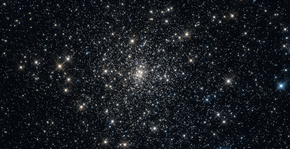NGC 6256 is a globular cluster of stars in the southern constellation of Scorpius. It was discovered by the Scottish astronomer James Dunlop on Aug 2, 1826.[6] In J. L. E. Dreyer's New General Catalogue annotation it is described as, "very faint, very large, very gradually bright in the middle, well resolved clearly consisting of stars."[7] The cluster is located at a distance of 22 thousand light-years (6.8 kpc) from the Sun.[2]
| NGC 6256 | |
|---|---|
 NGC 6256 as seen through the Hubble Space Telescope | |
| Observation data (J2000 epoch) | |
| Constellation | Scorpius |
| Right ascension | 16h 59m 32.68s[1] |
| Declination | −37° 07′ 17.1″[1] |
| Distance | 22 kly (6.8 kpc)[2] |
| Apparent magnitude (V) | 11.3[3] |
| Apparent dimensions (V) | 7′[4] |
| Physical characteristics | |
| Absolute magnitude | −7.15[citation needed] |
| Estimated age | 13.0±0.5 Gyr[2] |
| Other designations | NGC 6256, GCL 49.1, ESO 391-SC6 and vdB-Hagen 208[5] |
This is an ancient cluster with an estimated age of about 13 billion years; it was formed during the very early stages of assembly of the Milky Way galaxy. The cluster is orbiting within the galactic bulge with a low orbital eccentricity. It is heavily reddened by extinction due to interstellar gas and dust.[2] The structure is very concentrated at the center, showing a post core collapse morphology.[8]
The HR diagram for this cluster displays two sequences of blue straggler stars, which are the products of stellar mergers. The bluer sequence is well-defined and narrow, most likely being generated over a short time span. The redder sequence is more sparse, being the result of a continuous process of formation. It is hypothesized that the bluer sequence was formed around the time of the cluster's core collapse about one billion years ago; an event that made stellar collisions more likely.[9]
The cluster contains a millisecond X-ray pulsar, designated IGR J16597-3704.[10]
References
External links
 Media related to NGC 6256 at Wikimedia Commons
Media related to NGC 6256 at Wikimedia Commons
